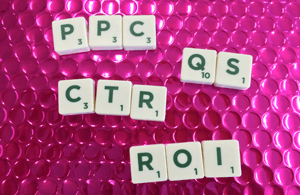 Do you know your PPC from your CPC or your CPA from your QS? Let’s see if we can de-mystify some of that pay-per-click jargon!
Do you know your PPC from your CPC or your CPA from your QS? Let’s see if we can de-mystify some of that pay-per-click jargon!
There are a lot of acronyms in the advertising world (an acronym is a shortening of a word, like AKA – Also Known As). I could rattle off a list of hundreds of jargonisations (it’s a word, I swear) but let’s focus today on those acronyms which crop up in Search advertising, starting with;
Search Advertising is any advertising you search for using a search engine, usually Google, Bing or Yahoo. It’s not advertising you see when you’re reading an article, we call that display advertising. You might hear Search advertising referred to as SEM (Search Engine Marketing) and it could be Paid Search (advertising you pay for) or it could be “free” SEO (that’s Search Engine Optimisation, when you employ strategies on or off your website to improve your rankings and visibility in Search Engines). You might also hear it called ‘Search’ (just an abbreviation of Search Advertising) or Paid Search (as above) or you might hear people call it PPC, which is not strictly accurate.
PPC is pay-per-click advertising and this is any form of advertising where you pay by the click. This means that it’s online advertising (because you can’t click on a newspaper or a bus stop poster) and the mouse click is what takes the visitor from your online advert through to your landing page.
Landing Page is often talked about and it is the specific page on your website that someone goes to when they click on your advert. You might hear this called the destination URL (URL is short for Uniform Resource Locator, but we don’t need to go into that!)
CPC is short for cost per click. Your cost per click is your total cost (amount that you’ve spent) divided by the total number of clicks on your advert. Example calculation: I have spent £100 on 50 clicks; £100/50=£2 so my CPC is £2.
Impressions or views are counted when your advert is shown. If you’re advertising on Google and your advert is shown 100 times (whether or not the advert was clicked on) then your advert has had 100 impressions. This will be broken down in AdWords (or AdCentre if you’re advertising on Bing or Yahoo) by campaign, ad group, ad or keyword.
CPM is not often used in search advertising and means cost per thousand impressions (in Latin mille means 1,000). If your advertising is set up as CPM you are paying for the number of impressions and not the number of clicks. This is more often used in Display advertising (like banner adverts) or sometimes Social advertising (paid adverts on social sites, like the adverts on the right hand side in Facebook). To calculate your CPM (or if you are not paying by CPM, this would be your eCPM – effective CPM) you take the total cost and divide it by the total impressions and them multiply it by 1,000. Example calculation: I have received 38,000 impressions and paid £100; £100/38000=£0.0026 (this is your cost per impression, but it’s such a small number that no-one uses this) multiply this by 1,000 and you’ll have your CPM: £0.0026*1000=£2.63.
CTR is an abbreviation of click-through rate, which is a ratio showing how often people who see your ad end up clicking it. This is the number of times your advert has been clicked compared with the amount of times it’s been shown, expressed as a percentage. CTR is often used as an indicator of quality of the ad-copy and of the relevance of the advert to the keywords which was searched. Example calculation: I have 32 clicks and 1,000 impressions. 32/1000=0.032 multiplying this by 100 will turn it into a percentage. 0.032*100=3.2% so my CTR is 3.2%. Don’t worry, you’ll rarely have to calculate your CTR as it is shown in your AdWords interface!
QS is a Google measure called Quality Score. It is a number given to each keyword in your campaign, between 1 and 10 (1 is bad, 10 is awesome). Your max bid (how much you say you’re willing to pay for a click) and your quality score determine which position you’ll appear in on Google and how much you will pay for your click. You can improve your Quality Score by making sure your keywords are relevant to your adverts and your adverts are relevant to your landing page and your website is well constructed, full of quality content and mobile friendly. There are other factors at play but these are the main things to take note of. You cannot calculate your own quality score and it is only shown at keyword level.
Average Position or AP is the average position your advert appeared in (and this can be reported at keyword level). The positions your adverts could appear in on the SERPs (That’s Search Engine Results Page) are 1st; the top slot under the search bar, 2nd; the one below that and 3rd; the one below that. Then you have positions four and more which are on the right hand side of the page and at the bottom of the listings. Your advert could appear on page two, three or even further back but as people rarely click past the first page you’ll normally be there, if you appear at all. Which position you appear in is a combination of your bid and your quality score. Don’t get too caught up in bidding to a certain position, just set you maximum bids to the most you would ever want to pay for a click, see what happens and take it from there.
That should cover everything you need to understand the performance of your PPC campaign at a basic level, but the one thing you need to look at over and above everything else is your ROI. ROI is Return on Investment and this is essentially the amount you got out of what you put in. Measuring this can be an exact science or a finger in the air sort of art form but you must make sure that you remember; advertising is designed to generate you business. Your goal is unique to you, it could be to increase footfall, or online sales or to push a specific product line or make people aware of a new product or service launch – whatever your goal, make sure you are getting a return from your advertising.
[bctt tweet=”Do you know your PPC from your CPC or your CPA from your QS?”]





